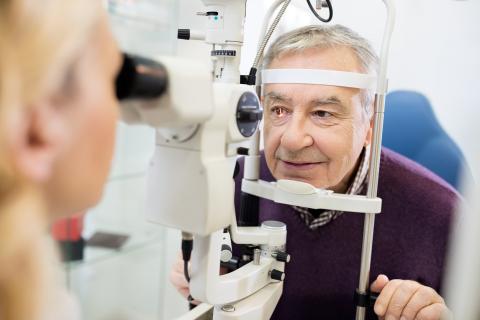February Is Age-Related Macular Degeneration Month
Age-related macular degeneration (AMD) is the deterioration of the center area of the retina of the eye. The retina is the layer of tissue at the back of the eye that transmits images to the brain through the optic nerve. The center area of the retina, called the macula, is responsible for the sharp central vision we use for reading, driving, identifying faces and so many other tasks.
There are two forms of macular degeneration, which a patient also can have at the same time:
Dry AMD occurs when the tissue of the retina thins and deteriorates. The light-sensitive cells break down, and central vision gradually becomes blurred. The condition usually progresses slowly over years.
Wet AMD, also called neovascular AMD, is caused by abnormal blood vessels growing under the retina. These new vessels are very delicate, and can leak blood and fluid behind the retina. The damage can occur quickly.
What causes AMD?
The causes of AMD are not entirely understood. But we know that the thinning of the macula and the development of abnormal blood vessels behind the retina are in part the result of wear and tear on our body systems. In fact, age is the top risk factor for developing AMD. Other risk factors include a family history of the disease, a diet that is high in saturated fat, smoking, and medical conditions such as obesity, high blood pressure, heart disease and high cholesterol. (It’s good to know that using our eyes to read, watch TV, etc., does not cause or worsen AMD.)
How is AMD diagnosed?
Though eyesight can be damaged without our realizing it, there might be early signs, such as blurred vision, a blank spot in your visual field, and trouble reading or recognizing faces. You might notice that you need a brighter light for reading or that night driving is more of a challenge. Your doctor may recommend that you test your vision with an Amsler grid. The AAO offers an online version.
In the early stage of AMD, our brains are able to compensate for subtle vision loss, especially if the condition is only present in one eye. So, routine dilated eye exams are important to allow your eye care professional to spot the condition early on.
Wet AMD may come on more suddenly. The most common symptom is distorted vision. Straight lines appear crooked, and very noticeable dark or blank spots may appear in your vision. This is because the blood and fluid leaking from the abnormal blood vessels push the macula out of position.
If you notice any of these signs, alert your eye care professional right away. The doctor will dilate your eyes with special drops that open the pupil so the back of the eye can be seen. Special imaging machines are used to take pictures of the retina from various angles.
Can AMD be cured or treated?
Dry AMD. The AAO says that there is no way to treat the dry form of the disease; however, certain lifestyle changes may prevent or delay further vision loss. These include having an annual eye exam, managing high blood pressure and cholesterol, exercising regularly, protecting the eyes from sunlight exposure, and avoiding smoking and second-hand smoke.
Nutrition is especially important. We should choose foods that have proven beneficial to eye health, such as dark, leafy greens, colorful fruits and vegetables, fish, and an all-around balanced, nutrient-rich diet. Ophthalmologists may also suggest that patients take AREDS supplements, a vitamin and mineral combination that may slow the progression of dry AMD. Ask your doctor to recommend the correct brand and formula.
Wet AMD. More progress has been made in the treatment of wet AMD, and this is very good news! Not so long ago, wet AMD often progressed to severe vision loss. But today, laser surgery and medications called anti-VEGF drugs can reduce the number of abnormal blood vessels in the retina, and slow the leaking of fluid and blood. The medications are injected into the eye, and while that might sound frightening, there is usually little or no discomfort.
According to the AAO, anti-VEGF injections can preserve vision in more than 90% of patients. “However, in the real world, the percentage is closer to 50% percent,” they caution. “One of the main reasons for this difference is that patients are undertreated. This is because most people with AMD must go to the ophthalmologist’s office for eye injections every six to eight weeks.” This can be challenging for older adults, especially if they are reliant on others for transportation to appointments and have other health conditions. Fortunately, research is underway on an implantable device that continually dispenses anti-VEGF drugs and would require far fewer appointments.
Living with AMD
People with AMD seldom lose all their sight. They can make the most of their remaining vision with special techniques and technologies. Vision rehabilitation specialists provide training in using side vision to make up for damage in the center, and teach patients how to do things in new ways. And they can keep patients up to date on new developments. These days, magnifiers, handheld computers, smartphone apps and large-print versions of all manner of items are better than ever. Most recent is the development of implantable miniature telescopes.
Home modifications also help. People with AMD can see better when there is more contrast between colors—for example, dark tape on the edge of light-colored stairs and the edges of countertops. Improved lighting can make a big difference, but brighter isn’t necessarily better—look for non-glare solutions.
AMD doesn’t have to mean the end of independence. Ask your doctor to recommend services and supports for people with low vision.
